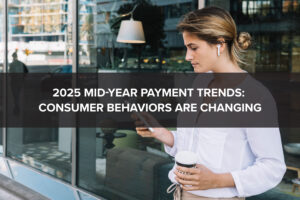 Consumers are adopting new behaviors and technologies more quickly than ever before. So, if you only take stock of payment trends during end-of-year planning, you can miss emerging trends and opportunities throughout the year. Staying informed about the following changes and trends gaining momentum mid-way through 2025 can help you refocus now, identify new opportunities, and equip merchants to offer the payment experiences that consumers demand. Staying on top of these trends will also help you position your ISV or VAR organization for even more success in 2026.
Consumers are adopting new behaviors and technologies more quickly than ever before. So, if you only take stock of payment trends during end-of-year planning, you can miss emerging trends and opportunities throughout the year. Staying informed about the following changes and trends gaining momentum mid-way through 2025 can help you refocus now, identify new opportunities, and equip merchants to offer the payment experiences that consumers demand. Staying on top of these trends will also help you position your ISV or VAR organization for even more success in 2026.
- Mobile Wallets
More and more, consumers are replacing their traditional wallets with mobile wallets. Whether the mobile wallets use either near-field communication (NFC) for tap-to-pay transactions or QR codes that consumers scan to make a payment, transaction volume is growing. Nasdaq reports that 25 percent of U.S. consumers use mobile wallets for in-person shopping, up 4.3 percent since 2022.Worldpay predicts that use will continue to grow and outpace debit transactions by 2027, when debit card payments will account for just 23 percent of point of sale transactions and mobile wallets will leapfrog to 31 percent. Gen Z consumers are the most likely to use mobile wallets, with 70 percent stating they have at least one mobile wallet. However, 22 percent of baby boomers and 40 percent of Gen X consumers are also using the technology, so merchants shouldn’t count them out.
- Contactless Payments
Consumers want frictionless payment experiences and contactless payments, whether using a card or mobile wallet. Over half (51 percent) of consumers make contactless payments — but expect that number to keep growing.Juniper Research is predicting contactless payments value to double by 2030 to reach $18.1 trillion worldwide. Expansion into new markets will drive most of that growth. For example, NFC ticketing for tap-in, tap-out access when entering a parking facility, event, or public transit are all natural use cases for contactless payment with little penetration right now.
- Gift Cards/Stored Value Cards
Gift cards are popular at the holidays and for gift-giving all year long. But a significant fraction of consumers keep them for themselves. Blackhawk Network reports that 33 percent of consumers buy them for self-use. Some like the fact that they are secure for online shopping. Others use them to get a discount or promotion, or to earn points or airline miles. They are also an excellent budgeting tool, allowing the consumer to set their budget ahead of time and then limit purchases to the value of the card. Regardless of the reasons consumers use stored value cards, merchants need a flexible, omnichannel gift card solution to capitalize on this demand.
Emerging Payment Trends
You’ll also need to keep the payment trends that are emerging in 2025 on your radar. ISVs and VARs should watch these up-and-coming payment methods:
- Payment Apps In-Store
As the number of payment apps increases, consumers will increasingly want the option to use them in-store. Systems capable of capturing payment data with QR codes will give merchants the flexibility to accept them.
- Growing Demand for Crypto Payments
Similarly, consumers may increasingly demand that cryptocurrency be accepted as a form of payment. Currently, 28 percent of Americans own it, 14 percent use it to make purchases, and 67 percent intend to buy more. While now limited to online purchases, users may want to use crypto in stores in the coming months.
- Biometric Payments
The biometric payment market is expected to grow to $34.71 billion by 2032, up from $8.53 billion in 2023. Biometric authentication on smartphones and laptops has increased consumers’ comfort level with the technology, and they may be open to using it to pay in stores. Watch for adoption of solutions that use facial, fingerprint, iris, or palm vein scans to capture payment data.
- Virtual Cards
Where traditional cards increase a consumer’s exposure to fraud by using the same number across vendors, virtual cards limit that exposure by generating new numbers with new expiration dates for each transaction. Global use of virtual cards is expected to explode from $19 billion last year to over $60 billion by 2030 as fears of security risks continue to grow among consumers.
Get Ready for Anything
While none of us can predict the future, we can all see that the industry and consumer behaviors are changing fast. Build agility into your solutions and form a partnership with a company that’s keeping an eye on trends and offering you the options that you and your merchants need. Contact us to discuss a partnership that will help you stay agile and ready to win business.



